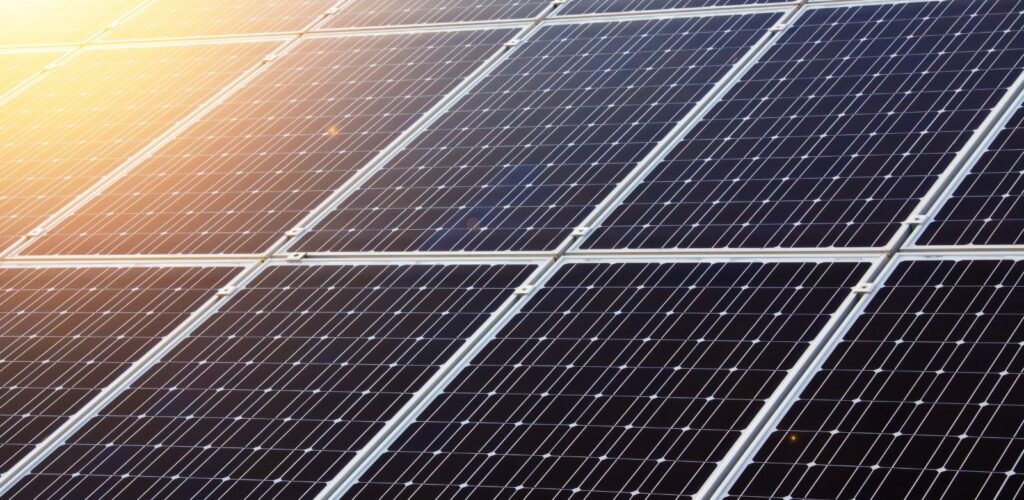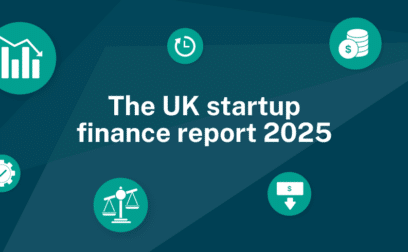The days of low-cost energy are over. Even with government intervention, many UK businesses are now paying more than double for their energy than they were a year ago. With this in mind and amid signals prices will remain well above normal levels for some time to come, many organisations are seeking ways to cut their energy bill. Solar power is one answer to this problem. Commercial solar panel systems can lop 60 – 70% off the cost of energy, saving the average small to medium sized business up to £5,400 every year.
Results like this indicate solar is a solid option, but some businesses still have questions: Is solar power reliable? How do these systems work? What kind of system do I need? Read on to discover all you need to know as we shine a light on commercial solar panels.
What are commercial solar panels?
Commercial solar panels are technology used to convert sunlight into electricity and they’re a good way to cut your business energy bill. Because businesses usually have higher demand for power than households, commercial solar panels are typically larger, absorb more light, and deliver more energy than panels made for use at home. They are also more expensive to buy and install than residential systems.
Although there are a number of different types of commercial solar panel, the most commonly installed systems use either monocrystalline or polycrystalline panels:
Monocrystalline panels are produced from one large block of silicon which is then cut into wafer-thin formats, giving them one of the highest efficiency ratings of 15 – 20%. They’re more compact than polycrystalline versions, so require less space to install. However, although they’re less affected by weather compared to other options on the market, their performance decreases as temperatures rise. They’re also the most expensive type of solar panel due to their high efficiency and the quality of silicon they use.
Polycrystalline panels are made by melting raw silicon. This faster and cheaper manufacturing process makes them less expensive than monocrystalline panels but gives them a lower efficiency rating of 13 – 17%. Due to their high-temperature tolerance, polycrystalline panels will usually generate more electricity over the year, but their cheaper construction means they’re more likely to have a shorter lifespan than monocrystalline options.
How do they work?
Solar panels, (also known as PV or photovoltaic panels) are made up of many individual cells that are manufactured from layers of semiconducting material — usually silicon. When light shines on the panels, a flow of electricity is created that can be used to power your business.
The power rating of solar panels is measured in kilowatts peak (kWp), which means the peak energy created by the panel in strong sunlight. Thus, a 250 kWp panel will generate 250 kilowatts of power at peak times. Converting this measurement into kilowatt hours (kWh), which is how commercial electricity is metered, is easy – a 250 kWp panel operating at full strength for one hour will deliver 250 kWh.
Most commercial solar panels will generate around 200 – 350 kWp of energy in strong sunlight, but the cells don’t need direct sun to work and can still generate power on cloudy days. Many businesses will also install a commercial battery storage system to prevent the loss of solar power. Batteries store any excess energy that is generated by your solar panels during daytime and make that spare electricity available for you at night.
What’s the difference between commercial and residential solar panels?
Commercial and residential solar panels are made of the same materials, and they work identically. The only differences are ones of scale:
- Commercial panels are usually larger than residential panels, which makes them heavier and requiring more space to install.
- Because of their larger size, commercial panels typically generate more power than the panels you might use at home.
- As you might expect, bigger size means bigger price. Commercial panels are more expensive to buy and install than residential systems.
How much do commercial solar panels cost in the UK?
Just as no two businesses are the same, so no two commercial solar panel installations are the same. Variables, such as the size and type of panel, the number of panels installed, the power needs of the business, and the ease or difficulty of installation, will affect the price you pay.
A small to medium sized business will spend anywhere between £16,000 and £70,000 for their solar array. This includes typical installation and VAT at 20% (fully reclaimable). Where installation is more complex (such as requiring reinforcement of a building’s roof), the installation costs could significantly increase the total price of the system.
| Approximate costs of UK commercial solar systems, including VAT and typical installation |
| Power output | Number of panels | Cost |
| 10 kWp 25 kWp 50 kWp 100 kWp | 30 50 100 200 | £16,260 £39,000 £78,000 £156,000 |
What are the advantages of commercial solar panels?
With energy costs going through the roof, installing solar panels on your roof makes great financial sense. However, as well as the energy savings businesses may enjoy from solar panels, there are other compelling reasons to install a solar system:
- Cost savings: Obviously, this is the biggest advantage of installing a solar panel system for your business. Solar panels generate free, sustainable electricity during daytime. The power can be used immediately or stored in batteries for use when the sun is no longer shining. This reduces your business’ demands for energy from the grid and the potential savings can be significant. Based on current business energy prices, a medium-sized commercial solar array of 30 kWp (kilowatts peak) could lower your electricity bill by £5,400 per year.
- Reduced dependence: Reduce your business’ dependence on the grid. Be less vulnerable to power cuts and outages. Generating electricity on-site lets your business remain in operation if the local power network goes offline.
- Sell your spare electricity: If you don’t use all of the solar power that you generate, your surplus power can be sold back to the grid.
- Lower your carbon footprint: Generating your own electricity with solar panels significantly reduces your company’s carbon footprint.
- Better Corporate Social Responsibility (CSR): Corporate Social Responsibility is a hot topic these days. As well as being better for the environment, solar panels demonstrate your business’s solid commitment to environmental sustainability.
What are the advantages of commercial solar panels?
With energy costs going through the roof, installing solar panels on your roof makes great financial sense. However, as well as the energy savings businesses may enjoy from solar panels, there are other compelling reasons to install a solar system:

Pros
- Cost savings: Obviously, this is the biggest advantage of installing a solar panel system for your business. Solar panels generate free, sustainable electricity during daytime. The power can be used immediately or stored in batteries for use when the sun is no longer shining. This reduces your business’ demands for energy from the grid and the potential savings can be significant. Based on current business energy prices, a medium-sized commercial solar array of 30 kWp (kilowatts peak) could lower your electricity bill by £5,400 per year.
- Reduced dependence: Reduce your business’ dependence on the grid. Be less vulnerable to power cuts and outages. Generating electricity on-site lets your business remain in operation if the local power network goes offline.
- Sell your spare electricity: If you don’t use all of the solar power that you generate, your surplus power can be sold back to the grid.
- Lower your carbon footprint: Generating your own electricity with solar panels significantly reduces your company’s carbon footprint.
- Better Corporate Social Responsibility (CSR): Corporate Social Responsibility is a hot topic these days. As well as being better for the environment, solar panels demonstrate your business’s solid commitment to environmental sustainability.
What are the disadvantages of commercial solar panels?
No energy system is perfect and that includes commercial solar panels. Even though your own solar system will save you money and deliver other worthwhile advantages, solar panels come with some disadvantages:

Cons
- Initial up-front cost: Solar panels can save you a lot of money in the long term, but they have a high up-front cost.
- They need space: The more panels you install, the more space you need. Does your roof have enough area to take the number of panels you need?
- Weather sensitivity: Solar energy can be generated even if it’s raining or very cloudy, but the efficiency of the panels will drop.
- Saving solar power for later can be expensive: Some businesses operate 24/7 and they need a 24-hour energy supply. Solar power must be used immediately, or it must be stored in large batteries – these kind of storage solutions can be expensive to maintain.
Is planning permission required for commercial solar panels?
If your commercial panel system is larger than 9m² you will need planning permission before beginning installation. Where the solar array covers an area of less than 9m², it must also meet the following conditions to avoid the need for planning permission:
- The solar array must be no more than 4 metres high.
- The solar array must be installed more than 5 metres from the property boundary.
- If located within a conservation area or a world heritage site, the solar array can’t face a highway or be visible from a highway.
In most cases, provided you meet the planning requirements and have enough roof space, you’ll be allowed to install solar panels on your business premises. Alternatively, if you require a large solar array, you may wish to install a solar farm. This is usually constructed at ground level and close to the site where power is needed, (such as a factory). Solar farms need local council approval, which will depend on factors such as:
- The visual impact of the solar farm.
- To what extent it will benefit the local community.
- The impact the solar farm will have on the surrounding ecosystem.
- Local electricity grid connectivity (can the grid accommodate a large-scale solar farm?)
Top tip: Even if you think your intended solar system does not need planning permission, it’s worth checking the legal details before commencing installation.
Can my business write off solar panels?
Yes. And businesses that make hay while the sun shines can write the cost off even faster. In 2021, in an effort to speed the post-COVID-19 recovery, the UK Government created the biggest two-year tax break for businesses in British history. One element of the plan was the 50% First Year Allowance (FYA). To claim this tax break, businesses must invest in qualifying plant and machinery by 31 March 2023. Commercial solar panels are qualifying investments. This means businesses that buy and install a commercial solar system before 31 March 2023 can claim back 50% of the cost in the first year, instead of the standard 6% per year write-down allowance.
Purchases of solar power systems after 31 March 2023 will still be deductible, but only at the standard write-down rate.
What is the lifespan of a commercial solar panel?
With proper care and maintenance, commercial solar panels should provide maximum output for 25 to 30 years.
What maintenance is involved?
Commercial solar panels have no moving parts. This helps keep maintenance to the minimum. However, like everything that’s exposed to the elements, dirt and grime will build up on the panels over time and this will reduce their operating efficiency. Fortunately, cleaning solar panels is no more complex that cleaning windows, and in most cases, a thorough clean will only be required every six months to keep the panels operating at full capacity.
The inverter units that convert each panel’s DC output into AC for business use will also need servicing. These units are more complicated than the panels, and depending on the design of the wiring system, they should be checked by a qualified technician once or twice per year.
Do solar panels lose efficiency with age?
Efficiency loss is minimal with modern commercial panels. Most will provide full generating output for 25 to 30 years and even after that, their rate of degradation is very slow – usually 0.2% to 0.3% per year. Many panels will still provide 95% of their ‘when new’ efficiency beyond their 30th birthday.
How long do they take to install?
No two commercial solar panel installations are alike and the time they take to install can vary enormously. Factors such as planning permission, the number of panels to be installed, the ease or difficulty of the location site, and any building work or fabrication that is required, will affect the time it takes to install your system.
Installation times could vary from two to three days for small systems that don’t need planning permission to many months for large systems and solar farms where planning permission is required.
How big are they?
Commercial solar panels vary in size, but on average, they measure 195cm x 100cm (77 inches x 39 inches). Based on these dimensions, a ten-panel system will occupy an area of 10m².
Do they still work on cloudy days?
Yes. Commercial solar panels do not need strong sunlight to generate electricity. They can work on rainy and cloudy days and throughout the winter. However, when light levels are low, generated power will be less than peak output.
Are solar panels worth it for business?
Every business is unique, so the decision to go solar will depend on individual circumstances. However, solar panels are a green and very reliable energy generating solution. Not only do they save money on energy costs they also promote your business as a sustainable operation.
Most businesses operate during daylight hours, so switching to solar to cut your electricity bills by up to 60 – 70% is an obvious choice. Even if your business works at night, you could still combine your solar panels with solar batteries to power your business after dark.
Before deciding if a commercial solar panels system is right for your business, consider these points:
- Are my energy bills too high and do I want to reduce them?
- Can I afford the upfront cost, or is there an economical way to finance this cost over time?
- Could I lease a solar panel system?
- Will going green benefit my business’ public image and generate more income?
For most organisations, the answer to all these questions will be ‘yes’. Solar panels are definitely worth it for business.
Are grants available for commercial solar panels?
There are no national grants available for the purchase and installation of commercial solar panels. However, depending on where your business is based, you may qualify for a regional business grant that covers this kind of investment.
Additionally, businesses that are just beginning may be able to secure a startuup loan of up to £25,000. These seed funds can be used for a variety of purposes, including the purchase of plant and machinery.
Lastly, if there are no regional grants available for your organisation, and a Startup Loan is not the answer, you could still finance your solar panel system through a commercial loan or lease option.
How can I finance the purchase and installation costs?
To remain competitive, businesses must extract every efficiency they can. With energy costs continuing to climb, cutting your electricity bill is a key consideration. Solar panel systems can replace your expensive grid energy and generate large savings over time, whilst economical financing can overcome the burden of the upfront cost. This combination of savings and low-cost access can make your switch to solar a simple choice.
Swoop provides an array of financing options for business. Many of these products may be used to buy and install the solar power your organisation needs. They include:
- Asset finance: Leasing that’s perfect for buying solar panels.
- Secured loan: Use your business collateral to secure the funds you require.
- Unsecured loan: No collateral required. Buy your solar panels over time.
- Small business loan: Available for businesses with less than 25 employees.
- Invoice finance: Funds are lent against the value of your accounts receivable. Unlock their potential to go solar.
- Revolving credit facility: Much like a bank overdraft. You dip into an open credit facility as and when funds are needed. The borrowing is repaid from your incoming business receipts.
Don’t let financial issues cloud your wish to go solar. Register with Swoop and let us help you find a loan or even a grant to help fund your move to solar.
Swoop requires writers to use primary sources to support their work. These include white papers, government data, original reporting, and interviews with industry experts. We also reference original research from other reputable publishers where appropriate.



































 yet? Register here!
yet? Register here!